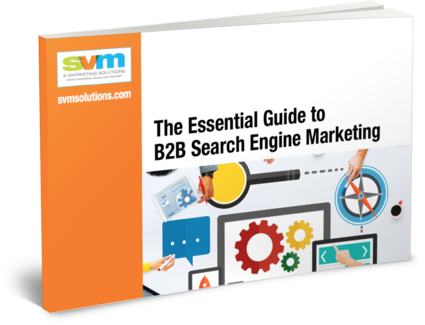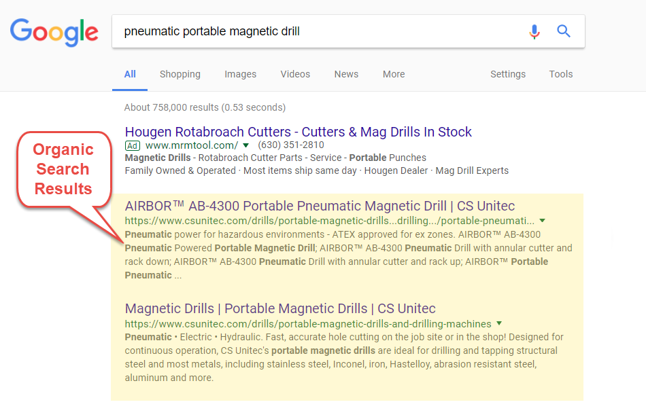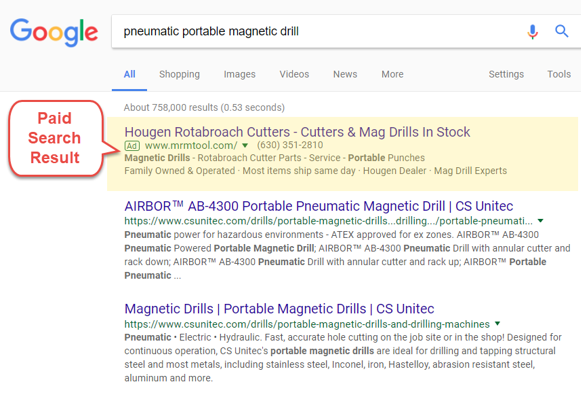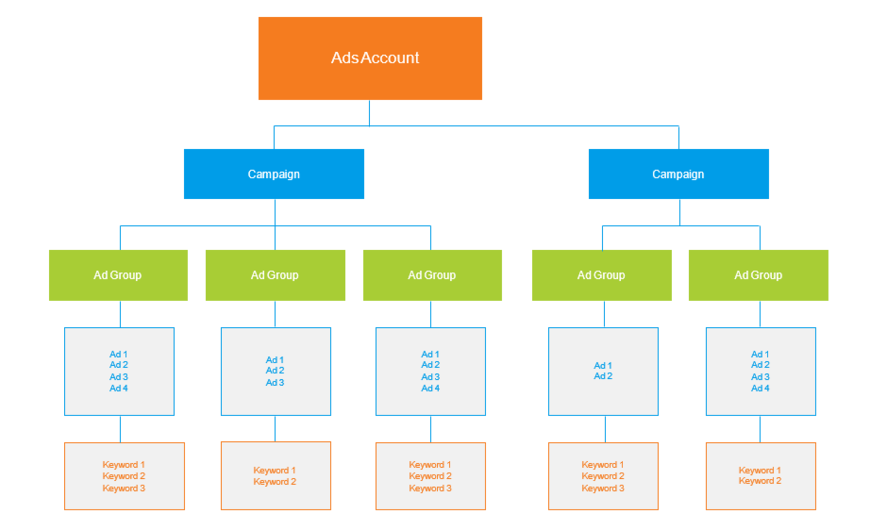CALL US TODAY: (877) 786-3249 x3
Schedule a Strategy Session


B2B search engine marketing can seem confusing, but it doesn’t have to be. To put you on the right path to search engine marketing success, I created this B2B search engine marketing guide.
To get started, download SVM’s B2B Search Engine Marketing Guide today!
We respect your privacy.
In 80% of B2B purchases today, the customer finds the supplier – not the other way around. If you are not actively engaging in search engine marketing, your website is not reaching its potential and you’re leaving money on the table.
B2B search engine marketing can seem confusing, but it doesn’t have to be. To put you on the right path to search engine marketing success, I created this B2B search engine marketing guide.
This guide will provide you with a step-by-step plan to:
Let’s get started!
What is B2B Search Engine Marketing?
Step 1: Define an Effective Search Engine Marketing Strategy
Step 2: Choose the Best Keyword Phrase
Step 3: Optimize Your Site for Organic Search
Step 4: Earn Inbound Links to Your Site
Step 5: Run a Paid Search Campaign
B2B Search engine marketing is the art and science of attracting motivated customers to your website by increasing your site’s presence within the search results of major search engines (i.e., Google, Bing and Yahoo). B2B Search engine marketing is crucial because 72% of customers begin at a search engine like Google when researching products and services online, according to research from Pardot.
Effective B2B search engine marketing begins with a thorough understanding of the keyword phrases your customers are searching for most often, and then leveraging a combination of Search Engine Optimization and Pay-per-click advertising to be found during those searches.




Search engine optimization, also known as SEO, is the ongoing process of making your website’s pages attractive to search engines. Webpages optimized for SEO achieve better rankings in organic, or unpaid, search engine results. According to research, approximately 75% of searchers will click on the organic results because they consider them more genuine. Google dominates B2B search with a 90% market share, according to research done by Optify, so most SEO campaigns focus on improving a site’s ranking in Google.
Your SEO campaign should focus on getting your website on the first page of the search results. The higher you are listed on the page the better, since most searchers prefer to click on the first few links. You can improve your rankings in search engines by focusing on two tactics:
SEO is very similar to public relations. It requires an ongoing, consistent effort to achieve results. Significant results can be achieved within a three- to six-month timeframe, and you will continue to build from there while laying a foundation to build upon.
With pay-per-click advertising, or PPC, your B2B company pays a predetermined amount to have text-based advertisements listed in paid search results. You will only be charged when a searcher actually clicks on your ad and visits your site, regardless of how often the listing is displayed. This makes pay-per-click advertising a results-focused advertising vehicle as compared to traditional print advertisements. With traditional ads in a print magazine, you are paying to be included in the publication regardless of the results the ad produces. With PPC, your ad can show up on the first page of Google all day long and you will not pay a dime unless someone actually clicks on your ad.
About 25% of searchers will click on the paid search results if they consider the ad relevant to what they are searching for. In essence, it pre-qualifies leads at a reasonable cost.
Your ranking in paid search results can be improved and optimized by focusing on three tactics:
Where search engine optimization takes months to start seeing results, pay-per-click advertising takes minutes. Your ads can start attracting targeted traffic immediately, but your campaign will require attentive management to ensure you are receiving the highest return on your pay-per-click advertising investment.
Many companies dive into search engine marketing without clear goals. Don’t make that mistake. Spend some time identifying the key elements of your search engine marketing strategy. The following steps will walk you through the process of defining that strategy.
B2B Search engine marketing will help drive targeted traffic to your website. Think about the goals and objectives for your website and online marketing efforts. Your B2B search engine marketing program should be designed to support these goals.
Some common B2B search engine marketing goals include the following:
If you don’t know who you’re trying to reach, you won’t be able to figure out how they search in order to help them find you. Begin by brainstorming about your target audiences.
Consider the following when defining your B2B search engine marketing audience.
Your B2B search engine marketing program must also focus on your competition. You want to make sure you clearly identify your top competitors, so you can continually evaluate how your company’s search engine presence ranks relative to the competition.
For each company or website you compete against, please define the following elements.
How will you know if your B2B search engine marketing strategy is a success?
Identify specific success metrics from the list below that will allow you to measure the impact your SEM strategy will have on your business. Be clear about what you want to achieve and make sure your goals are attainable.
Some common B2B search engine marketing success goals include:
Keyword research, the process of strategically selecting the most important keyword phrases for your company, is the most critical step in search engine marketing. If you do not perform this step properly, there is no way that your campaigns will be successful.
When choosing the best keyword phrases, it is critical to choose phrases that are not only relevant to your business, but also ones that are searched for most often by your customers. The keywords have:
There is an art and a science to the keyword research process. The art of the process focuses on brainstorming about the phrases you think your customers are searching. The science portion of the process will tell you the estimated search volume by phrase, based on recent search history.
Keyword research services can help you with these steps. The following exercises will help you leverage this process to identify the best keyword phrases for your company.
Begin your keyword research with the art of the process and brainstorm phrases you think customers use when searching for your products and services.
Get all of your customer-facing team members involved and consider the following questions:
To assist your brainstorming process, you can leverage a number of online services that allow you to peek at what keyword phrases your competitors are focusing on with search engine marketing. Using Spy-Fu’s free search, you will be able to learn their approximate pay-per-click budget, best paid keywords, top organic keywords and other useful information. While Spy-Fu is primarily fee-based, you can perform a free search to preview the research details.
After completing the keyword brainstorming exercise, you will have a seed list of keyword phrase candidates. Next, turn to the science of keyword research to determine how frequently people search these terms.
Keyword research tools that aggregate and estimate search volumes are available to take the guesswork out of the research process. These tools will reveal the keyword phrases on your list that are frequently used, as well as expand your list by showing variations, qualifiers and alternative spellings that are also searched in high volume.
The following tools are great resources that can be used during the keyword research process:
At this stage you will know the most popular phrases by search volume, but you should not focus on popularity alone. You must also focus your efforts on popular phrases that are most relevant for your website’s content and product offering. Review your keyword list and assign a priority for each keyword phrase, using the following grading scale:
Grade A and Grade B keyword phrases are good candidates for your organic search engine optimization and pay-per-click advertising efforts. Your Grade C terms are not good candidates for organic search engine optimization, but can work well for pay-per-click advertising. When optimizing your website for organic search traffic, begin with your most popular Grade A terms and work down the list.
For organic search engine optimization, focus on 30 to 50 Grade A and B phrases at a time. I recommend limiting yourself to that number because optimizing your website takes a significant amount of time and effort, and I don’t want you to spread your efforts too thin. Achieve a top ranking for your top phrases, then move on to the next set of phrases, always driving more targeted traffic with each initiative.
For pay-per-click advertising, it is relatively easy for you to focus on an extensive list of phrases without harming your campaign.
Once you have uncovered your most important keywords, make sure your website’s content is optimized to drive qualified traffic to your website.
Begin with your website copy. Make sure it effectively markets your company while using your important keyword phrases in a relevant fashion. If you do not have creative writers in-house, you can contract many talented and affordable freelancer writers on websites like Upwork or Zerys, or you can hire a professional marketing copywriter to create your content. After the copy is optimized, your web team should focus on optimizing your website’s coding – the HTML “under the hood” or behind the scene pages of your website that search engines see when they crawl your website. The optimization process includes planning, writing and coding.
After ranking your phrases by search volume, try to get a handle on your chances for search engine optimization success. Most likely there are millions of pages competing for the searcher’s attention for a given keyword phrase. If the phrase is very competitive, you may be fighting a long, uphill battle to get on the first page. Begin by creating a keyword plan for your search engine optimization campaign.
Keyword-rich copy is critical to SEO success. Unfortunately, a lot of web copy is poorly written because the people placed in charge of Web copywriting do not understand how to write for search engine success. There are a number of successful strategies for creating compelling, search engine-friendly copy for your website.
In addition to content people can read, your website must be optimized “under the hood” and programmed to adhere to current SEO coding best practices. To do this effectively, your web team should have SEO masters on board. If you don’t, you can hire a third-party SEO expert from Upwork or Guru to direct programming efforts. There is an art and science to this SEO coding process, and the science side can fill a book. Here are some important coding elements your technical people should focus on.






Link building involves earning quality links to your website from other websites that are frequented by your customers and prospects and that are important in your industry. The more quality inbound links you earn, the more popular your website is in the eyes of Google and other engines. The links can have a huge effect on your search ranking.
Don’t confuse this with outbound links (links from your website to other third-party websites). Outbound links can have a negative impact on your search ranking if they are misused.
Link building is the most impactful – and most neglected – SEO strategy. Recently, I talked to a company that learned this the hard way. They completed a sizable investment in a new website with a great design that was optimized for top search engine position. However, they couldn’t get a ranking higher than a competitor who had a very poor website with an old, outdated design. After reviewing their situation, I determined that link popularity was the reason. Although the competitor’s website was poorly designed, it had thousands of natural inbound links to a number of articles posted on its website. The company I was advising had fewer than 100 inbound links that were not from reputable websites.
I like to use the “fill the bucket” metaphor when describing link building. Think of your website as a bucket where each relevant inbound link is a stream of water into your bucket. We want your website bucket filled with as much water as possible. Each outbound link is a leak in your bucket. To keep your website bucket full, you need to have many more quality inbound links than outbound links.
By consistently applying the following link-building strategies, you will significantly impact your ranking on search engines and boost your online popularity.
Organic search engine optimization is great, because effort and investment will result in traffic to your website that you don’t have to pay for. However, there are many reasons why you should include pay-per-click (PPC) advertising in your marketing mix:
The key to pay-per-click advertising is to make sure you are running a results-focused campaign that tracks your return on investment (ROI). I like to think of it more as a financial model than an advertising model. You are paying for specific visits to your Website, and want to make sure you are getting a sizable return on that investment.
Google Ads is by far the most popular pay-per-click advertising platform because Google is the most popular search engine. As mentioned earlier, Google dominates B2B searches with a 90 percent market share. If you are just getting started with PPC advertising, I recommend you focus your efforts exclusively on Google Ads.
To ensure your Google Ads campaign gets off on the right foot, it is important to understand the Ads system structure so you can set up your account properly.
Visual representation of the Google Ads structure:


As you know by the term “pay per click” advertising, you pay Google only when someone clicks on your ad. That’s good news for you if you structure your account well. If you’ve done it correctly, you’ll only pay for targeted traffic to your Website.
Google determines how much you pay for click according to an “auction” model, which is driven by an Ad Rank algorithm based on two key factors: a maximum cost-per-click that you set (so you’ll never pay more for a click than you specify), and your Quality Scores (defined below). By using both cost and quality factors in the algorithm, Google can ensure quality search results for users while still making money.
Google assigns Quality Scores to keywords on a 10 point scale representing Google’s measure of your ads’ effectiveness for each keyword. Quality scores are based on a number of factors, including:
These factors are determined by algorithms, past account performance, and other factors that Google deems appropriate.
The closer your quality scores are to 10, the more relevant Google thinks your ads are. This leads to better performance, improved ad position, and lower cost per click. By improving your Google Ads account, you can improve quality scores and lower costs over time. To see a keyword’s quality score, view that column in the “Keyword” tab of your account.
When you set a maximum cost-per-click (CPC) bid for a keyword, you tell Google the highest amount that you are willing to pay for a click on your ads for that keyword. However, your max CPC is not what you’ll end up paying most of the time.
If your Max CPC and Quality Scores are high enough to win the auction among all the advertisers bidding on a keyword, your actual cost-per-click (CPC) is determined by the following formula:
The Ad Rank of the runner up / your quality score + $.01
So, you should bid high enough to achieve a good Ad Rank and put your ad in a strong position, but never bid more than you are willing to pay per click.
Ad Rank is determined through this equation:
Max CPC bid x quality score
One of the best features of PPC advertising is how targeted it can be. You have tremendous control over where your ads are viewed, including where the visitor is located and the websites your ad displays on, as well as the devices that can be used to view your ad. Specifically, your Google Ads campaign can be targeted in the following ways:
The keyword research tactics you learned earlier in this guide will be invaluable for your Google Ads PPC campaign. However, the way you use and deploy these keywords is very different from your SEO campaign. Since you are paying for each ad click, you want to make sure your ads are showing for targeted, niche phrases that only your most likely customers will be searching.
Begin by understanding keyword match types. Leveraging the appropriate match types can often make or break a PPC campaign. Match types help control the keyword phrases that trigger your ads to display. Generally, Google offers the following match options:
| Match Type | Example | Ads May Show For | Ads Will Not Show For |
|---|---|---|---|
| Broad Match | work boots | work boots buy work boots best boots for work work boot laces black work boots work shoes | No limits |
| Broad Match Modifier | +work +boots | work boots buy work boots best boots for work work boot laces black work boots | work shoes |
| Phrase Match | "work boots" | work boots buy work boots work boots laces black work boots boots work | work shoes best boots for work |
| Exact Match | [work boots] | work boots work boot boots work boots for work | buy work boots best boots for work work boot laces black work boots work shoes |
| Negative Match | "work boots" - laces | work boots buy work boots black work boots | work boot laces best boots for work |
In addition to filtering the types of keyword matches to prevent unwanted – or potentially costly – clicks, Google’s Keyword Planner within the Ads system will help you manage the Ads opportunity by estimating traffic and costs by keyword. Enter the phrases on your keyword list into this tool, and it will tell you:
After you have identified your best keyword phrases, organize them into related Ad Groups. Focus on a handful of phrases that are closely related to a common theme. Advertisements are created at the Ad Group level, but keyword phrases are what actually trigger the ads. To ensure the most relevant ad is displayed, the keyword phrases in an Ad Group must relate to that ad. The more specific your Ad Group structure, the better you ads will perform.
With so many ads competing for a searcher’s attention, your pay-per-click ads really need to stand out on the first page. Unlike traditional advertisements, paid search ads impose strict character limits. You’ll notice when you write your first ad that there is little room to work with, so make sure each element is clear and concise.
Make sure you let results drive your bidding strategies. Don’t fall short like so many companies do and focus on the amount you’re paying for each click. Think cost per lead and cost per sale instead of just cost per click.
You’ll notice that I called them “bidding strategies.” That’s intentional. Everything in this process should be thought out, monitored and adapted as necessary. In other words, it needs to be approached strategically.
In addition to the strategies mentioned earlier, Google offers a number of services that allow you to quickly boost your company’s exposure in the search results.
If you’ve got a brick and mortar retail location, there’s another online tool you can use to your advantage for SEO. Visit Google My Business and use the tools there to manage your business listing on Google. This listing affects how people see your business when searching on Google.com and Google Maps.
You can use Google My Business to:
Even if you don’t have a retail location, you should take advantage of Google My Business for your office address. It could still help your customers, and it will help enhance your website’s profile on Google.
If you’ve got products that you can assign prices and photos to, you’d be wise to use Google Merchant to get on Google Shopping. With this tool, you can create a data feed of your products to Google via a spreadsheet, XML or API-accessed upload. While the requirements and specifications are strict, an effort to create an accurate data feed could pay big dividends.
While your presence on Google Shopping will not affect your organic results, it can be a very effective form of pay per click advertising because it drives visitors directly to your site when they are searching for specific products.
Measuring the success of search engine marketing activities helps identify the actionable insights for improving future marketing activities.
Although every business is unique, and every website has different metrics that matter, the following suggestions for measuring your search engine marketing success are nearly universal:
This search engine marketing guide outlines a proven approach to getting more high-quality leads.
Now it’s time to take action to profit from these principles. Assemble a team of qualified web designers and online marketing strategists to take your company’s search engine marketing to the next level.
We hope this search engine marketing guide has helped simplify the process of attracting profitable traffic to your website. The principles detailed in this guide are based on SVM’s over twenty years of experience creating effective online marketing strategies that produce measurable business results for manufacturers, distributors and B2B service providers. For more guided online marketing strategies, take a look at our guide resource center. We have a guide for each high-level online marketing activity.
A great next step will be to setup a free consultation with me, Bob DeStefano, to discuss your B2B online marketing strategy.
I guarantee I’ll provide you with tips and ideas you can use immediately to boost your results.